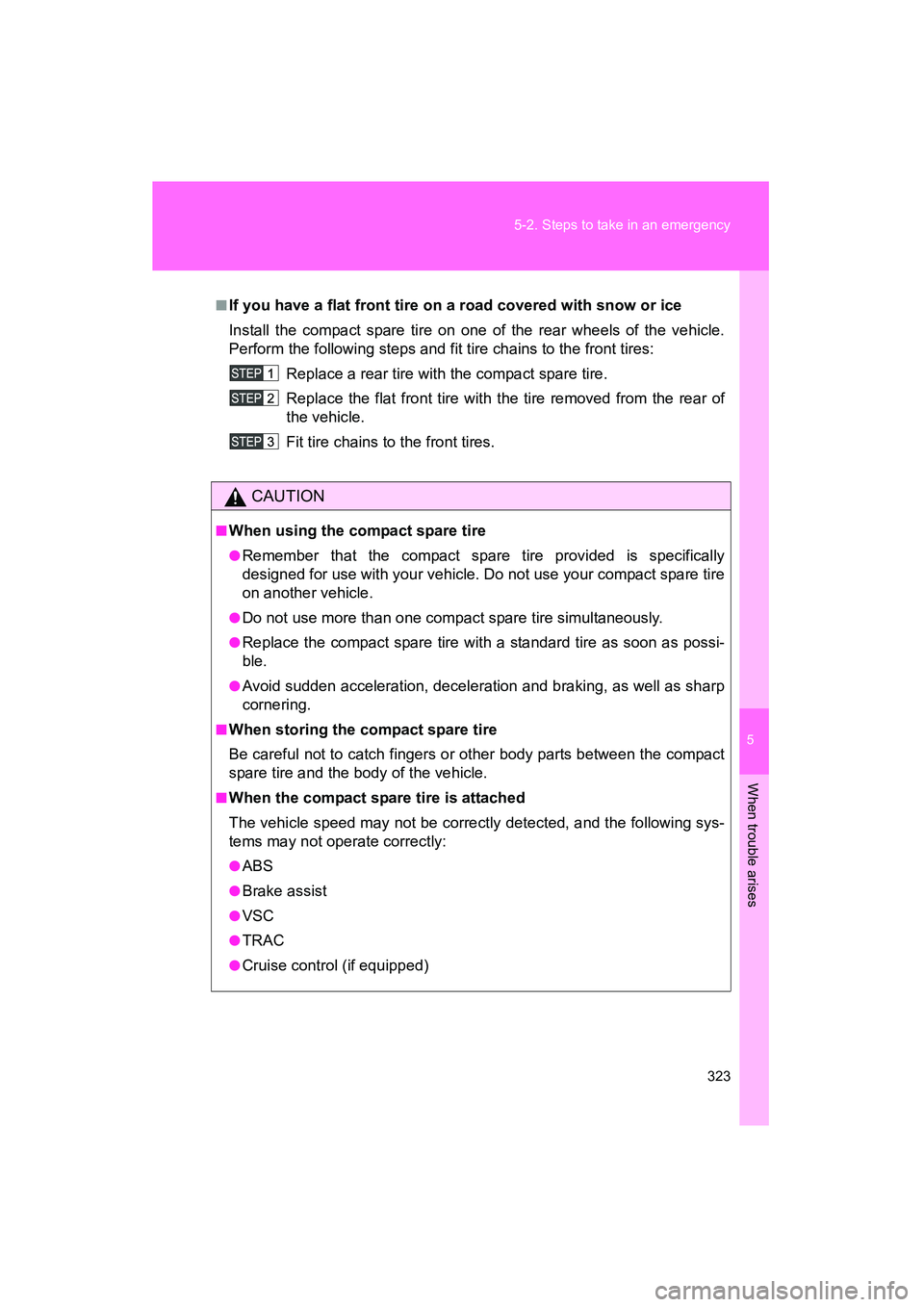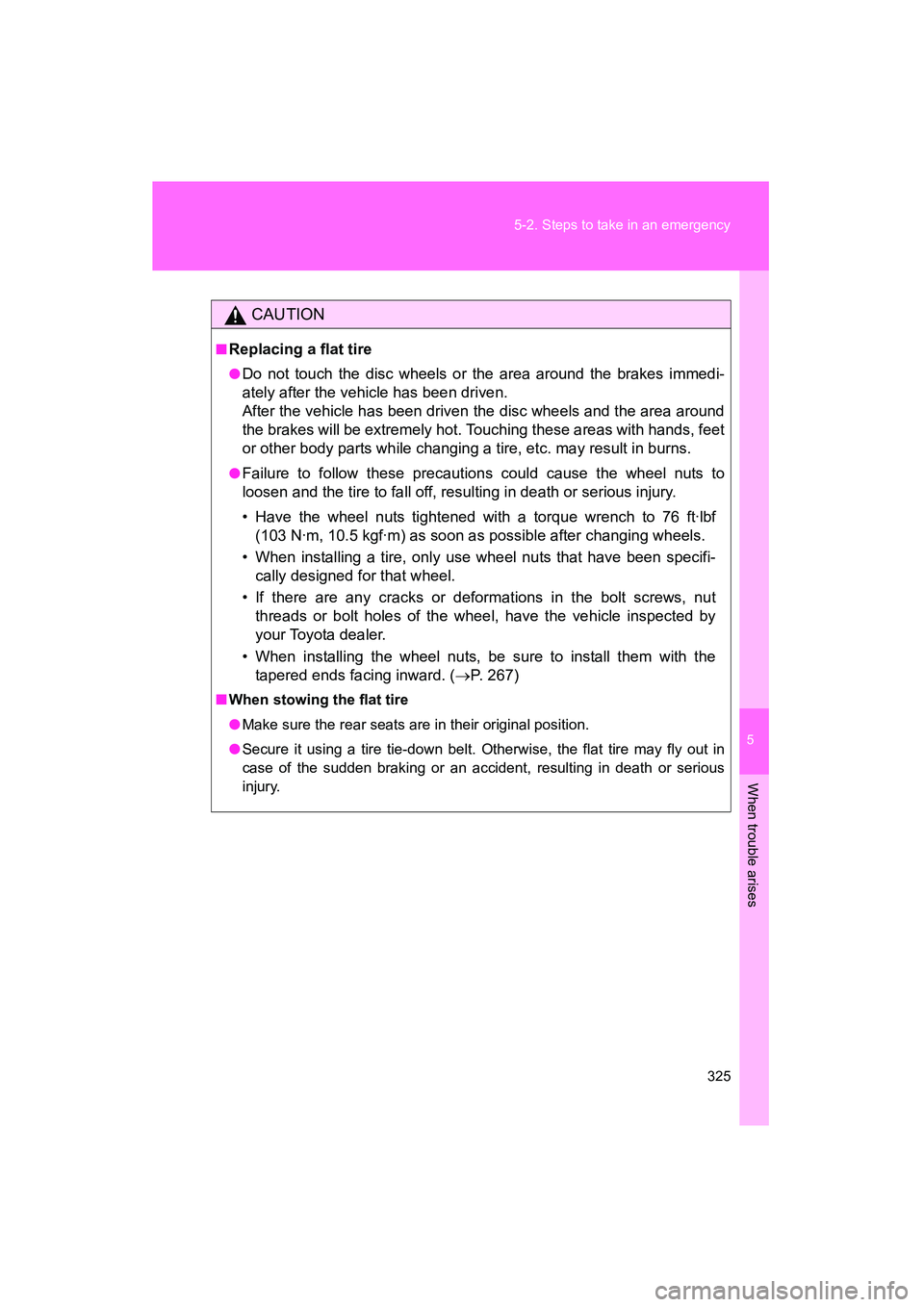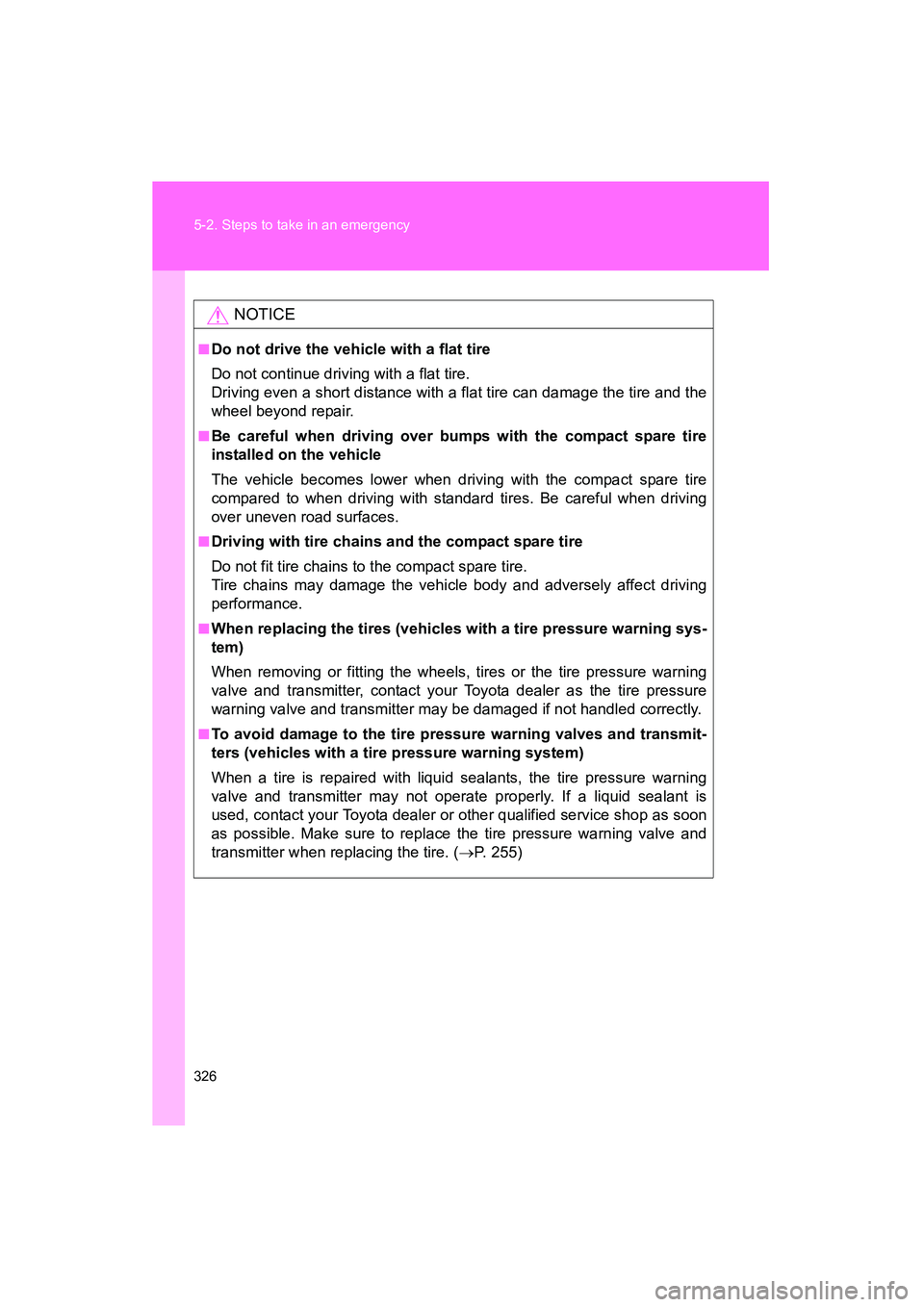Page 319 of 403
5
When trouble arises
317
5-2. Steps to take in an emergency
YARIS_HB_U_52D44U
Replacing a flat tire
Chock the tires.
For vehicles with steel wheels,
remove the wheel ornament
using the wrench.
To protect the wheel ornament,
place a rag between the wrench
and the wheel ornament.
Flat tire
Wheel chock
positions
Front
Left-
hand
sideBehind the
rear right-
hand side
tire
Right-
hand
sideBehind the
rear left-
hand side
tire
Rear
Left-
hand
sideIn front of
the front
right-hand
side tire
Right-
hand
sideIn front of
the front
left-hand
side tire
Page 320 of 403
318 5-2. Steps to take in an emergency
YARIS_HB_U_52D44USlightly loosen the wheel nuts
(one turn).
Turn the jack portion “A” by hand
until the notch of the jack is in
contact with the jack point.
Raise the vehicle until the tire is
slightly raised off the ground.
Remove all the wheel nuts and
the tire.
When resting the tire on the
ground, place the tire so that the
wheel design faces up to avoid
scratching the wheel surface.
Page 321 of 403
5
When trouble arises
319
5-2. Steps to take in an emergency
YARIS_HB_U_52D44U
Installing the tire
Remove any dirt or foreign mat-
ter from the wheel contact sur-
face.
If foreign matter is on the wheel
contact surface, the wheel nuts
may loosen while the vehicle is
in motion, causing the tire to
come off.
Install the spare tire and loosely tighten each wheel nut by
hand by approximately the same amount.When replacing a steel wheel
with a compact spare tire, tighten
the wheel nuts until the tapered
portion comes into loose contact
with the disc wheel sheet.
When replacing an aluminum
wheel with a compact spare tire,
tighten the wheel nuts until the
tapered portion comes into loose
contact with the disc wheel
sheet.
Disc wheel sheet
Tapered portion
Disc wheel sheet
Tapered portion
Page 322 of 403
320 5-2. Steps to take in an emergency
YARIS_HB_U_52D44ULower the vehicle.
Firmly tighten each wheel nut
two or three times in the order
shown in the illustration.
Tightening torque:
76 ft·lbf (103 N·m, 10.5 kgf·m)
Stowing the flat tire, jack and all tools
Stow the jack and all tools. Return the deck board.
Page 323 of 403
5
When trouble arises
321
5-2. Steps to take in an emergency
YARIS_HB_U_52D44U
Vehicles with an aluminum
wheels, remove the center wheel
ornament by pushing from the
reverse side.
Be careful not to lose the wheel
ornament.
Hook each belt end to the cor-
responding anchor brackets.
Put the center portion of the
belt onto the rear center head
restraint.
Lay the flat tire on the luggage
floor so that the outer side of the
tire wheel faces toward the rear
of the vehicle. Detach the rear
center head restraint from the
seat and release the belt.
Pass the belt through the center
hole of the flat tire wheel.
Page 325 of 403

5
When trouble arises
323
5-2. Steps to take in an emergency
YARIS_HB_U_52D44U
■If you have a flat front tire on a road covered with snow or ice
Install the compact spare tire on one of the rear wheels of the vehicle.
Perform the following steps and fit tire chains to the front tires:
Replace a rear tire with the compact spare tire.
Replace the flat front tire with the tire removed from the rear of
the vehicle.
Fit tire chains to the front tires.
CAUTION
■When using the compact spare tire
●Remember that the compact spare tire provided is specifically
designed for use with your vehicle. Do not use your compact spare tire
on another vehicle.
●Do not use more than one compact spare tire simultaneously.
●Replace the compact spare tire with a standard tire as soon as possi-
ble.
●Avoid sudden acceleration, deceleration and braking, as well as sharp
cornering.
■When storing the compact spare tire
Be careful not to catch fingers or other body parts between the compact
spare tire and the body of the vehicle.
■When the compact spare tire is attached
The vehicle speed may not be correctly detected, and the following sys-
tems may not operate correctly:
●ABS
●Brake assist
●VSC
●TRAC
●Cruise control (if equipped)
Page 327 of 403

5
When trouble arises
325
5-2. Steps to take in an emergency
YARIS_HB_U_52D44U
CAUTION
■Replacing a flat tire
●Do not touch the disc wheels or the area around the brakes immedi-
ately after the vehicle has been driven.
After the vehicle has been driven the disc wheels and the area around
the brakes will be extremely hot. Touching these areas with hands, feet
or other body parts while changing a tire, etc. may result in burns.
●Failure to follow these precautions could cause the wheel nuts to
loosen and the tire to fall off, resulting in death or serious injury.
• Have the wheel nuts tightened with a torque wrench to 76 ft·lbf
(103 N·m, 10.5 kgf·m) as soon as possible after changing wheels.
• When installing a tire, only use wheel nuts that have been specifi- cally designed for that wheel.
• If there are any cracks or deformations in the bolt screws, nut threads or bolt holes of the wheel, have the vehicle inspected by
your Toyota dealer.
• When installing the wheel nuts, be sure to install them with the tapered ends facing inward. ( →P. 267)
■When stowing the flat tire
●Make sure the rear seats are in their original position.
● Secure it using a tire tie-down belt. Otherwise, the flat tire may fly out in
case of the sudden braking or an accident, resulting in death or serious
injury.
Page 328 of 403

326 5-2. Steps to take in an emergency
YARIS_HB_U_52D44U
NOTICE
■Do not drive the vehicle with a flat tire
Do not continue driving with a flat tire.
Driving even a short distance with a flat tire can damage the tire and the
wheel beyond repair.
■Be careful when driving over bumps with the compact spare tire
installed on the vehicle
The vehicle becomes lower when driving with the compact spare tire
compared to when driving with standard tires. Be careful when driving
over uneven road surfaces.
■Driving with tire chains and the compact spare tire
Do not fit tire chains to the compact spare tire.
Tire chains may damage the vehicle body and adversely affect driving
performance.
■When replacing the tires (vehicles with a tire pressure warning sys-
tem)
When removing or fitting the wheels, tires or the tire pressure warning
valve and transmitter, contact your Toyota dealer as the tire pressure
warning valve and transmitter may be damaged if not handled correctly.
■To avoid damage to the tire pressure warning valves and transmit-
ters (vehicles with a tire pressure warning system)
When a tire is repaired with liquid sealants, the tire pressure warning
valve and transmitter may not operate properly. If a liquid sealant is
used, contact your Toyota dealer or other qualified service shop as soon
as possible. Make sure to replace the tire pressure warning valve and
transmitter when replacing the tire. (→P. 255)